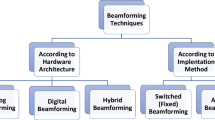Abstract
A simplified relay antenna selection with source beamforming (RAS-BF) scheme is advocated for multiple-input multiple-output (MIMO) two-way relaying networks (TWRNs) employing amplify-and-forward (AF) protocol, which does not require channel estimation at the relay node and the optimal relay antenna can be simply determined by comparing the minimum received pilot signaling powers pertaining to each antenna. The theoretical analysis of system outage probability and average symbol error rate (SER) shows that full diversity order can also be achieved by the simplified scheme. Simulation results are provided to verify our theoretical results and further illustrate that the simplified scheme outperforms the outage-optimal counterpart in the presence of channel state information (CSI) imperfections.
摘要
创新点
针对采用放大转发协议的多输入多输出双向中继网络, 提出了一种基于源端波束成形的简化中继天线选择方案。 该方案不要求中继节点进行信道估计, 而仅需比较每根天线接收到的较小导频信号功率即可确定最优中继天线。 通过推导系统中断概率和平均符号错误率, 证明了所提简化方案也可获得满分集阶数。 仿真结果验证了理论分析的正确性, 并进一步说明提出的简化方案在非理想信道状态信息条件下优于中断最优方案。
Similar content being viewed by others
References
Chen S, Zhao J. The requirements, challenges, and technologies for 5G of terrestrial mobile telecommunication. IEEE Commun Mag, 2014, 52: 36–43
Rankov B, Wittneben A. Spectral efficient protocols for half-duplex fading relay channels. IEEE J Sel Areas Commun, 2007, 25: 379–389
Arti M K, Bhatnagar M R. Two-way mobile satellite relaying: a beamforming and combining based approach. IEEE Commun Lett, 2014, 18: 1187–1190
Pei Y, Liang Y C. Resource allocation for device-to-device communications overlaying two-way cellular networks. IEEE Trans Commun, 2013, 12: 3611–3621
Shakeri R, Khakzad H, Taherpour A, et al. Performance of two-way multi-relay inter-vehicular cooperative networks. In: Proceedings of IEEE Wireless Communications and Networking Conference, Istanbul, 2014. 520–525
Zhang C S, Ge J H, Li J, et al. Robust power allocation algorithm for analog network coding with imperfect CSI. Sci China Inf Sci, 2014, 57: 042312
Hwang D, Nam S, Lee T, et al. Finite feedback MIMO precoding for the two-way amplify-and-forward relay network. IEEE Commun Lett, 2014, 18: 620–623
Rashid U, Tuan H D, Kha H H, et al. Joint optimization of source precoding and relay beamforming in wireless MIMO relay networks. IEEE Trans Commun, 2014, 62: 488–499
Park H, Chun J, Adve R. Computationally efficient relay antenna selection for AF MIMO two-way relay channels. IEEE Trans Signal Proc, 2012, 60: 6091–6097
Amarasuriya G, Tellambura C, Ardakani M. Joint beamforming and antenna selection for two-way amplify-and-forward MIMO relay networks. In: Proceedings of IEEE International Conference on Communications, Ottawa, 2012. 4829–4834
Yang K, Yang N, Xing C, et al. Relay antenna selection in MIMO two-way relay networks over Nakagami-m fading channels. IEEE Trans Veh Tech, 2014, 63: 2349–2362
Anghel P A, Kaveh M. Exact symbol error probability of a cooperative network in a Rayleigh-fading environment. IEEE Trans Wirel Commun, 2004, 3: 1416–1421
Guo H, Ge J H. Diversity order of multiuser two-way relay networks with beamforming over Nakagami-m fading channels. Sci China Inf Sci, 2011, 54: 1986–1990
Gradshteyn I S, Ryzhik I M. Table of Integrals, Series, and Products. 7th ed. Amsterdam: Academic Press, 2007
Ilhan H. Performance analysis of two-way AF relaying systems over cascaded Nakagami-fading channels. IEEE Signal Proc Lett, 2012, 19: 332–335
Xia X, Zhang D, Xu K, et al. Interference-limited two-way DF relaying: symbol-error-rate analysis and comparison. IEEE Trans Veh Tech, 2014, 63: 3474–3480
Simon M K, Alouini M S. Digital Communication Over Fading Channels. Hoboken: John Wiley & Sons, 2005
Li J, Ge J H, Zhang C S, et al. Impact of channel estimation error on bidirectional MABC-AF relaying with asymmetric traffic requirements. IEEE Trans Veh Tech, 2013, 62: 1755–1769
Wang C, Deng K, Li Y B, et al. A simple amplify-and-forward opportunistic relaying based on outdated channel state information. Sci China Inf Sci, 2014, 57: 062301
Wang L, Cai Y, Yang W, et al. Performance analysis of transmit beamforming and relay selection with feedback delay and channel estimation errors. In: Proceedings of IEEE International Conference on Wireless Communications & Signal Processing, Hangzhou, 2013. 1–6
Author information
Authors and Affiliations
Corresponding author
Rights and permissions
About this article
Cite this article
Li, J., Zheng, Y., Ge, J. et al. Simplified relay antenna selection with source beamforming for MIMO two-way relaying networks. Sci. China Inf. Sci. 60, 022310 (2017). https://doi.org/10.1007/s11432-015-0352-4
Received:
Accepted:
Published:
DOI: https://doi.org/10.1007/s11432-015-0352-4




